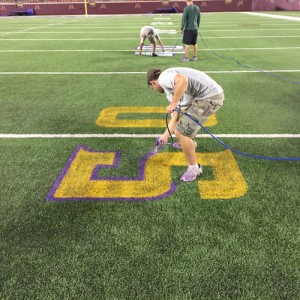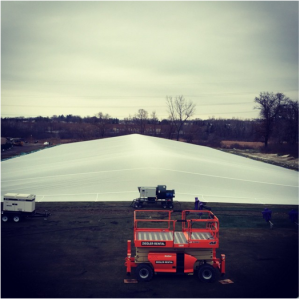A Viking’s voyage: Flexibility is key for Minnesota team’s turf manager
Flexibility has become second nature to the Minnesota Vikings Head Sports Turf Manager Grant Davisson. Between sharing a home stadium and maintaining the franchise’s three separate facilities in Minnesota’s extreme seasonal weather, Davisson’s days are never identical.
Davisson started working for the Vikings in 2000 as a crewmember and was offered a full-time position as the turf assistant in 2004. He moved into his current role in 2007 and now is charged with maintaining all of the Vikings’ sports turf.
Home-field advantage
Starting next season, the Vikings will play their home games in the new U.S. Bank Stadium. There is currently no flooring on the field level, and the bidding for artificial turf has not started. The artificial turf is scheduled to be installed starting in May.
For the 2014 and 2015 seasons, the Vikings are playing their home games at the University of Minnesota Golden Gophers’ TCF Bank Stadium.
Sharing the field takes a close partnership between Davisson’s crew and the university’s staff. Luckily, the two teams have experience after sharing the Hubert H. Humphery Metrodome from its opening in 1982 until 2008.
“We are basically a vendor in TCF Stadium, and we try to accommodate them as much as we can,” Davisson says. “At the Metrodome we were No. 1, and now we are No. 2, but it has worked out really well.”

Painting the 50-yard line at TCF Bank Stadium for an upcoming Minnesota Vikings game. Photo courtesy Zeno Group
After each Vikings or Gophers game Davisson, his two full-time employees and two interns work hand-in-hand with the university’s crew to remove the markings and then paint the logos of the next team playing at the stadium. A group of nine to 12 people are usually working together on the switch.
Most weekends, the joint coalition can take their time transitioning from the Gophers’ maroon and gold to the Vikings’ purple and gold or vice versa. There are occasional weekends when both teams have home games and the timetable to complete the job is short.
One such weekend recently happened and Davisson says they set a new record for changing over the field.
The Gophers wrapped up a 32-23 home win against the University of Illinois at 2:30 p.m. on Nov. 21, and the combined crew started scrubbing logos 30 minutes later. After working at a furious pace to complete the field, Davisson says they were cleaning their painters four hours and 22 minutes later at 7:22 p.m.
“We had a game the next day (Nov. 22) at 2:30 p.m. so that gave us just enough time for the paint to dry,” Davisson says. “It’s not easy to cure paint when it’s less than 30 degrees.”
Hitting the road
When Davisson isn’t at the downtown Minneapolis TCF Bank Stadium he is either at the Vikings’ Winter Park practice facility in the Minneapolis suburb of Eden Prairie, Minn., or at Minnesota State’s campus 70 miles away in Mankato, Minn., for training camp.
Davisson and his crew are at the Winter Park practice facility daily to maintain the two Kentucky bluegrass outdoor fields and one indoor field with artificial turf.
To get Minnesota State’s facilities up to NFL specifications two members of the Vikings’ crew are sent to Mankato to live on campus leading up to and during training camp. Davisson says he personally visits once a week during the growing period and everyday during training camp. He adds that he has made the trip to Mankato more than 500 times in his career.
But August is the busiest time for the Vikings’ turf management team and when Davisson says he really starts to rack up the miles.
“My travel during that time I call it the triangle because I travel to all three facilities everyday,” Davisson says. “I either start or end my day at training camp in Mankato and then I go to Winter Park to get the fields ready for when camp ends. I have to visit the stadium too because we have to get that ready for the preseason games.”
Summer’s heat or winter’s cold
Because a majority of the team’s games are played outdoors Davisson says the players prefers to practice in the same conditions. This leads to Davisson’s biggest challenge — keeping the Winter Park natural grass practice fields disease-free and alive throughout the entire season.

Davisson and his crew test out the MacLeod Cover for the first time last year. Photo courtesy Grant Davisson @grdturf
“It’s amazing the disease pressure on natural grass to go from 90 degrees and humid in July and August and then after you have a couple months to start focusing on snow mold,” he says. “At the same time, we are plowing all the fields so we have to make sure you get the fungicide into the plant.”
Even if the crew is successful keeping the practice field disease-free in November and December they still have to keep the turf alive. Last season, the Vikings invested in a MacLeod Cover, an inflatable and translucent cover that allows for photosynthesis and airflow from Covermaster, to keep one of the Kentucky bluegrass fields growing during a possible Vikings playoff run.
“Weather is the No. 1 thing in my life,” Davisson says. “My locker is full of clothes for all weather.”











